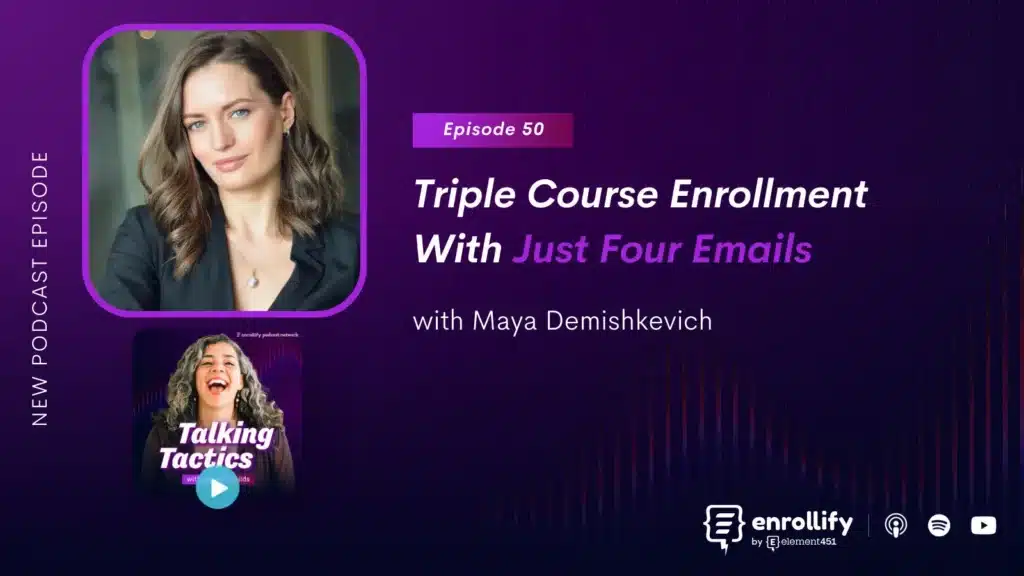
If you work in higher education, especially on the continuing education side targeting adult learners, you probably know this frustrating cycle:
- You launch great course or training.
- You send out an email to your database.
- A few people register — but not enough to run the class.
- You cancel.
- Repeat.
Over the years, I’ve seen this play out at many institutions. And here’s the thing: it’s usually not because the courses aren’t valuable (although sometimes they could be stronger — but that’s another story).
More often, it’s because the way we market and communicate about them is missing the mark.
I’ve learned a lot from helping turn around underperforming courses and training programs — and in this article, I’m sharing one practical, cost-effective fix you can put to work right away: email.
Common Problems (and What to Do Instead)
1. You send one email and hope for the best.
A single announcement email is easy to miss or ignore. People are busy, and inboxes are overflowing.
✅ Fix: Create a short email sequence (3–4 emails) leading up to the course. Each message should have a distinct focus:
- Benefits-focused: What will participants gain?
- Logic-focused: Why does it matter? What’s the ROI? Use facts, data, rationale.
- Social proof: Who else has done it and found value? Share testimonials.
- FOMO + urgency: Why should they act now? Highlight what they’ll miss if they don’t sign up.
2. Your emails sound like a brochure.
Many course promotions copy-and-paste catalog descriptions into emails. But a dry summary rarely inspires action.
✅ Fix: Write like a human, not a catalog.
- Use a conversational, first-person tone.
- Sign emails from a real person — not “Continuing Education Department.” It adds warmth and trust.
- Personalize when possible.
- Format for readability. Short paragraphs, clear headers, and bullet points.
3. You overlook the “why.
We focus on what the course is, but forget to tap into why someone would care.
✅ Fix: Understand your audience.
- What are their pain points or goals?
- How will this course help them?
- What objections might they have?
Shape your messaging around those insights.
4. Your subject lines and preheaders are weak.
Even the best email will flop if no one opens it. Weak subject lines and preheaders (the preview text next to the subject line) don’t spark curiosity or urgency.
✅ Fix: Use stronger subject lines and preheaders.
- Create curiosity
- Highlight urgency or exclusivity
- Be clear and specific on what the email contains
- Test a few options to see what resonates with your audience.
5. The call to action feels cold or generic.
“Register now” or “Learn more” isn’t always compelling.
✅ Fix: Make it feel like an invitation.
- Try “Join us,” “Be part of this group,” or “Save your spot.”
- Use language that creates belonging, urgency, or exclusivity.
- Include multiple calls to action: mix in-text links and buttons that appeal to curiosity, logic, and emotion.
6. You’re not leveraging psychology.
Effective marketing isn’t just about facts — it’s about human behavior.
✅ Fix: Apply simple psychological triggers:
- Hope of gain: Show how the course solves a problem.
- Social proof: Highlight testimonials or success stories.
- Scarcity: Mention limited spots or deadlines.
- Desire to belong: Emphasize joining a community, not just attending a class.
If you want to explore 26 additional psychological triggers, check out Joseph Sugarman’s excellent book Triggers: 30 Sales Tools You Can Use to Control the Mind of Your Prospect, to Motivate, Influence, and Persuade.
Results You Can Expect
When you put these practices in place, you may notice:
- Higher open and click-through rates on your emails
- More inquiries and registrations
- Fewer canceled classes
- A stronger reputation for offering in-demand, relevant training
💬 Lessons and Takeaways
Here’s what you can bring to your institution:
- Email is still powerful — when done right. Move beyond “announcement” blasts to intentional campaigns.
- Train your team. Marketing might not be everyone’s background, but with the right framework, non-marketers can succeed.
- Focus on enrollment, not vanity metrics. Open rates are nice — but enrollments are the real goal.
- Leverage psychology. Appeal to hope, identity, belonging, and urgency — not just logic.
- Start small, scale up. Begin with one program, test, and expand from there.
Need help with email marketing? Don’t hesitate to reach out.
🎧 Want to hear a real-world case study?
Check out my interview on the Talking Tactics with Dayana Kibilds, where we unpack how we tripled course enrollment with just four emails: Episode 50 — Triple Course Enrollment With Just Four Emails

Latest Posts: Keep Reading
- Should Colleges Use Social Media to Ask for Donations?
- 9 Simple but Powerful Marketing Reminders from eduWEB Summit
- Why Your Courses Aren’t Filling — And One Approach That Can Help
- What It Really Takes to Do Social Media Right in Higher Ed
- Take Control of Your College’s Paid Search Advertising: Own Your Data!
